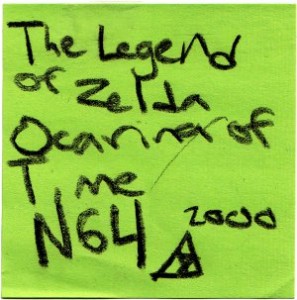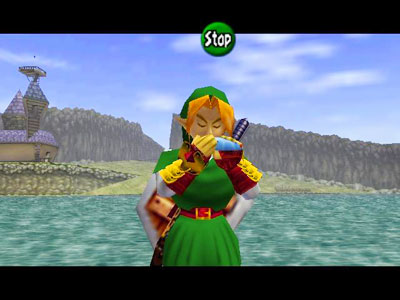Maker Faire 2011 Roundup: Zelda
Written by ben // August 17, 2011 // Events // No comments
 The Zelda franchise began in 1986, with the release of The Legend of Zelda for the Nintendo Entertainment System. It was the first cartridge that came with battery-backed storage. Zelda’s competitors used long complex passcodes to “save” the player’s progress, and these sharply limited the amount of data that could go into a savegame. Zelda used its battery-backed storage to keep three savegame files with detailed information on the player’s progress and discoveries, and used the extra space to provide what was, at the time, a truly enormous and varied world.
The Zelda franchise began in 1986, with the release of The Legend of Zelda for the Nintendo Entertainment System. It was the first cartridge that came with battery-backed storage. Zelda’s competitors used long complex passcodes to “save” the player’s progress, and these sharply limited the amount of data that could go into a savegame. Zelda used its battery-backed storage to keep three savegame files with detailed information on the player’s progress and discoveries, and used the extra space to provide what was, at the time, a truly enormous and varied world.
The Legend of Zelda was an enormous success, and a sequel was released in 1988. This sequel diverged sharply from the formula used in the original game. It took the form of a sidescroller with roleplaying elements, including experience and levels. While considered an excellent game, the series returned to its roots in 1991, with The Legend of Zelda: A Link to the Past, on the Super Nintendo.
 So far, Nintendo has released fourteen conventional Zelda-style games, as well as several spinoffs and variations. They all follow a similar pattern. The main character, Link, begins the game in a relatively safe space, acquires a sword, and goes to fight monsters. Link discovers new abilities as the game continues, sometimes by exploring the world, sometimes by going deep into dungeons. These abilities prove crucial for later dungeons and areas of the world. Eventually Link defeats the bad guy (usually the Dark Lord Ganondorf or his beast form Ganon) who has kidnapped the eponymous princess Zelda.
So far, Nintendo has released fourteen conventional Zelda-style games, as well as several spinoffs and variations. They all follow a similar pattern. The main character, Link, begins the game in a relatively safe space, acquires a sword, and goes to fight monsters. Link discovers new abilities as the game continues, sometimes by exploring the world, sometimes by going deep into dungeons. These abilities prove crucial for later dungeons and areas of the world. Eventually Link defeats the bad guy (usually the Dark Lord Ganondorf or his beast form Ganon) who has kidnapped the eponymous princess Zelda.
While the fundamentals are consistent, the details of the games vary widely. Wind Waker takes place on a water planet, with Link traveling from island to island via a talking boat. Ocarina of Time gives Link a musical instrument that he can use to play world-changing melodies, as well as a sword that permits him to travel forward and back through time. Twilight Princess introduces the Twilight Realm, a dark parallel world that forces Link to explore as a wolf. Nearly every Zelda game makes extensive use of some unique game mechanic.
 For the most part, the Zelda series has no fixed chronology. Each Zelda game involves the approximate same characters doing approximately the same things, but in a completely different world. The Zelda franchise is closer to repeated retellings of a myth than a conventional series of sequels. A few Zelda games are explicitly sequels to previous games, but this is an exception rather than a rule, and the original Link and Zelda’s ancestors – inevitably named “Link” and “Zelda” – play their expected roles in the sequel just as they did in the original. Sequel or not, the games borrow heavily from previous Zelda games, constantly enriching and improving the universe, with original-NES elements like bombs and the Octorok side-by-side with Ocarina of Time’s Skull Kid.
For the most part, the Zelda series has no fixed chronology. Each Zelda game involves the approximate same characters doing approximately the same things, but in a completely different world. The Zelda franchise is closer to repeated retellings of a myth than a conventional series of sequels. A few Zelda games are explicitly sequels to previous games, but this is an exception rather than a rule, and the original Link and Zelda’s ancestors – inevitably named “Link” and “Zelda” – play their expected roles in the sequel just as they did in the original. Sequel or not, the games borrow heavily from previous Zelda games, constantly enriching and improving the universe, with original-NES elements like bombs and the Octorok side-by-side with Ocarina of Time’s Skull Kid.
 The Legend of Zelda series was the main reason we decided to provide voting information by series. While Zelda games overall claimed 36 votes, topping the series chart, only one Zelda game claimed more than ten votes. We received votes for no less than eight separate Zelda games, with most of the votes going to the original Nintendo game and to Ocarina of Time.
The Legend of Zelda series was the main reason we decided to provide voting information by series. While Zelda games overall claimed 36 votes, topping the series chart, only one Zelda game claimed more than ten votes. We received votes for no less than eight separate Zelda games, with most of the votes going to the original Nintendo game and to Ocarina of Time.

